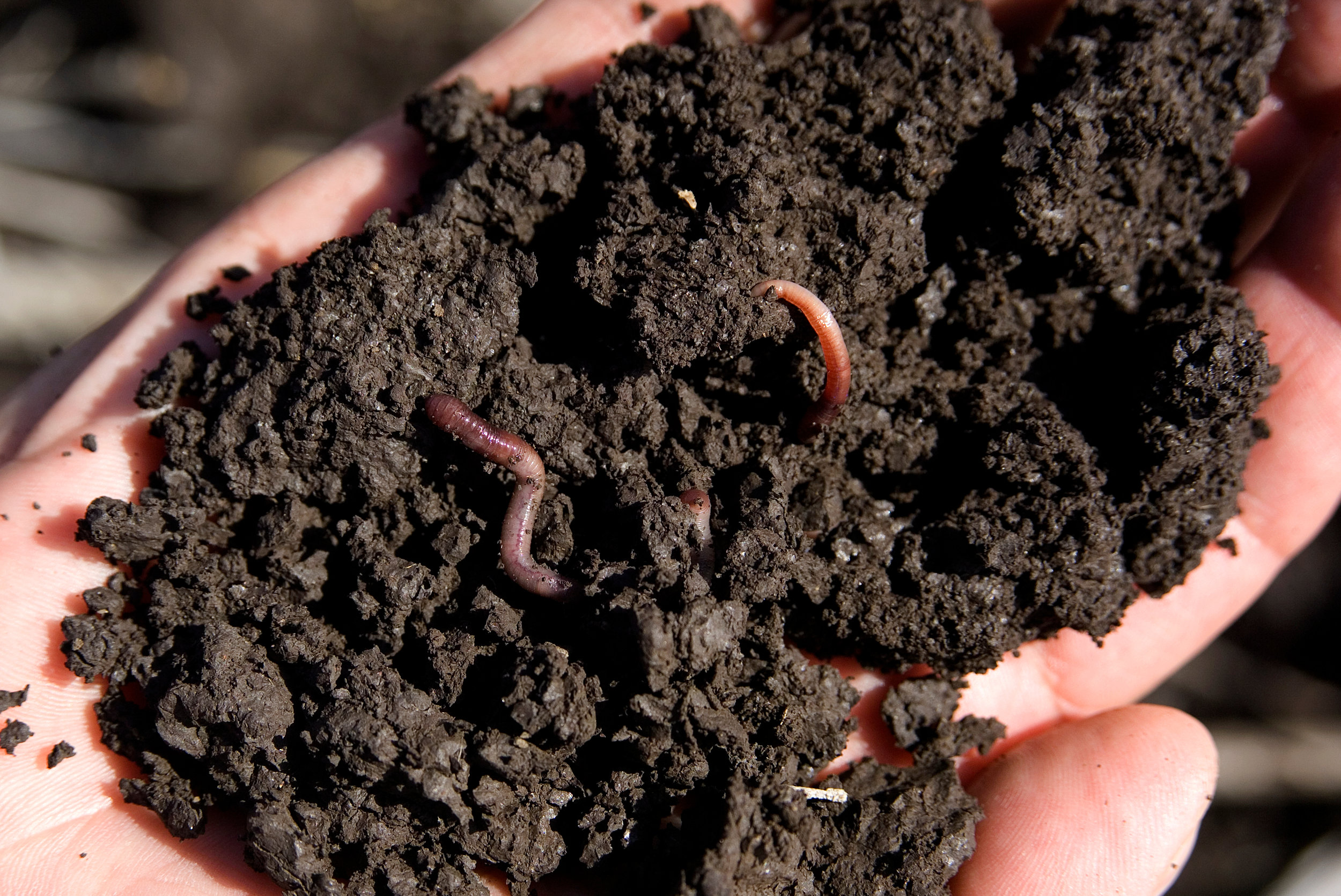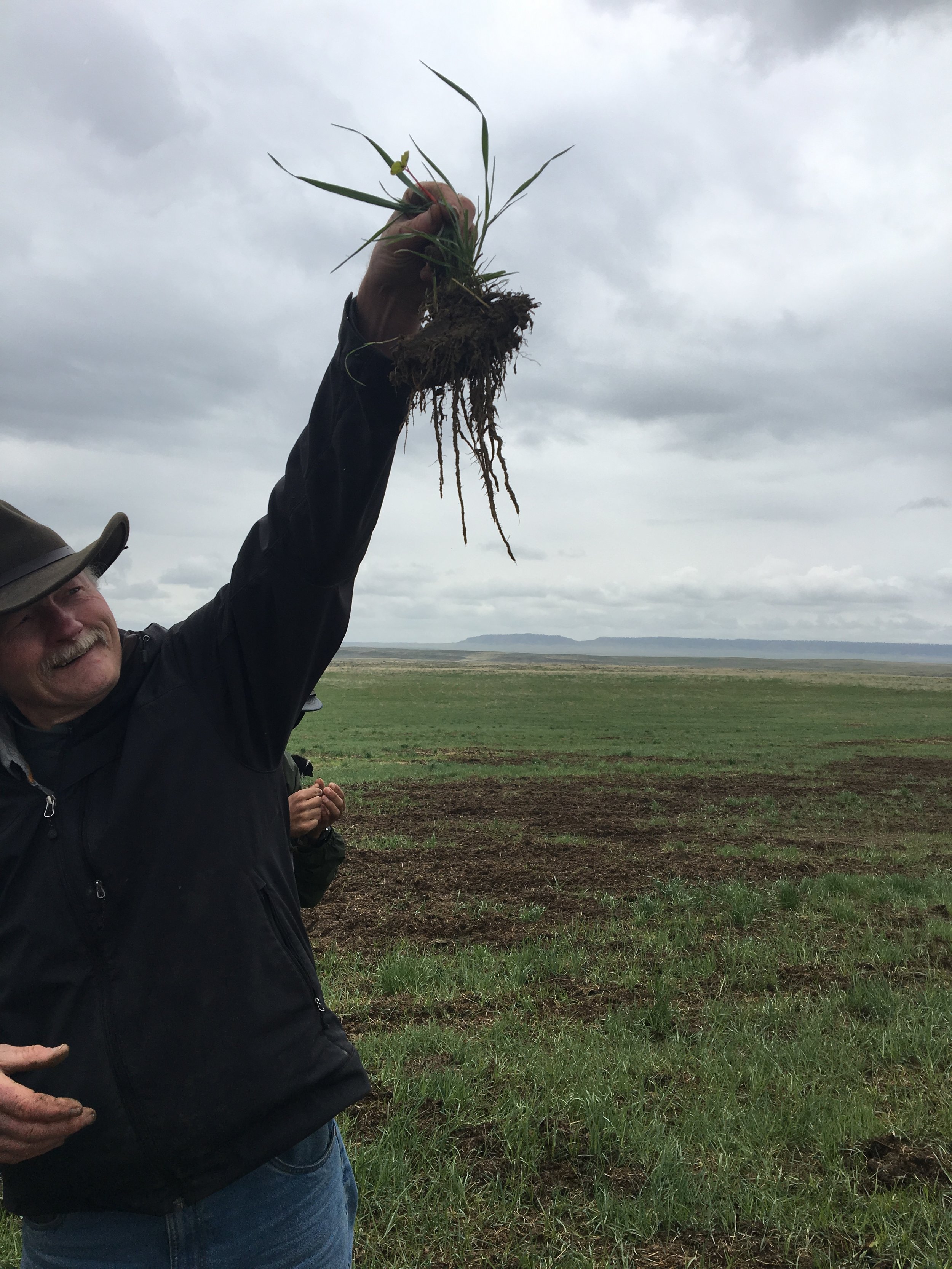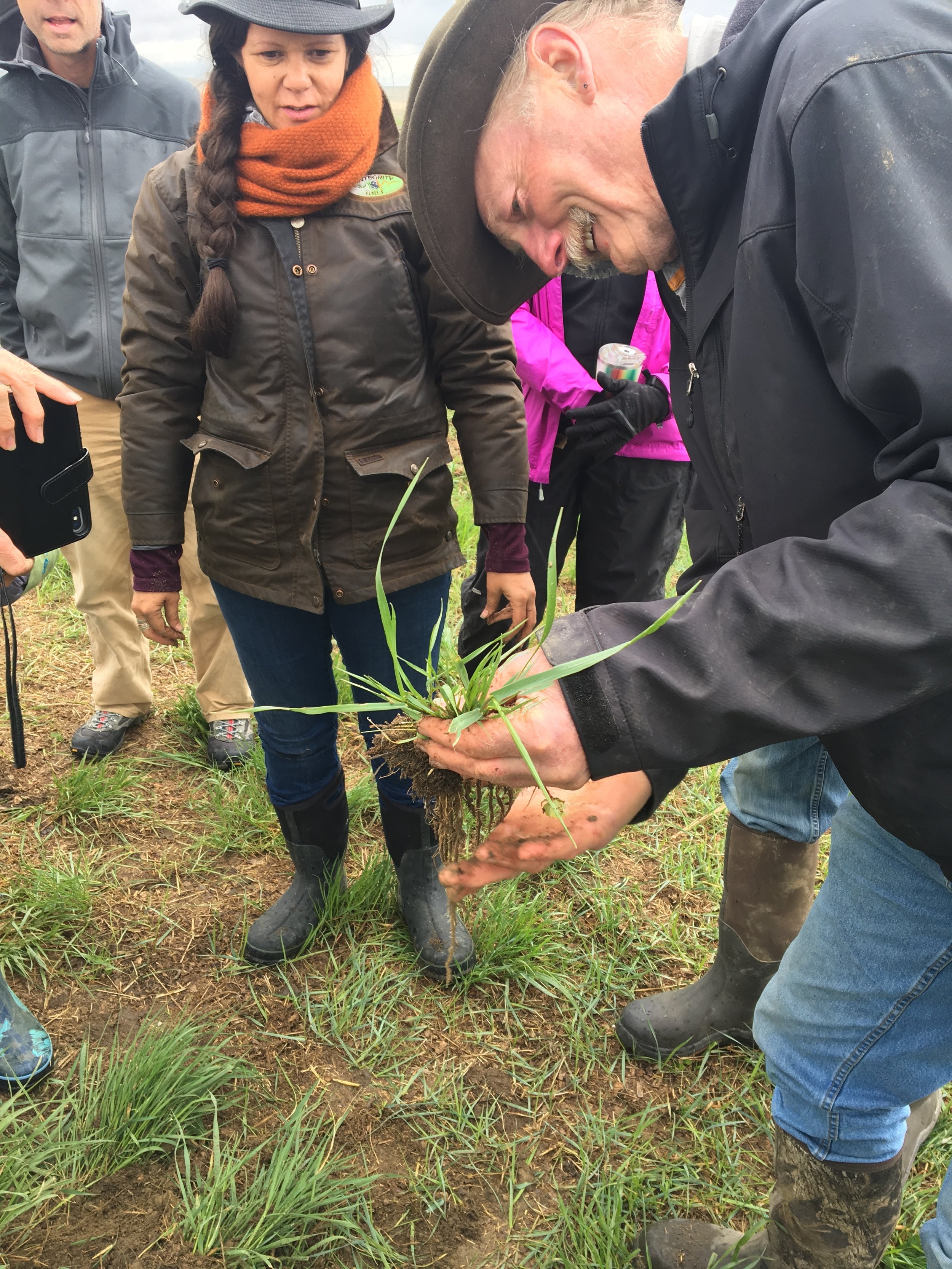John Brown:
A Passion for Soil Health
John Brown views his life in cycles. He categorizes his life into different phases that have all been integral to form who he is today and how he came to be so devoted to soil health in this cycle of his life.
Looking out across grassy, northern plains pastures in Shepherd, Montana, John explains how he categorizes his life.
“My life goes in these seven or eight year cycles, with a new occupation or new drive about every seven or eight years. Many times I was really frustrated by that because there didn’t seem to be any continuity, but I like it now. I know that it's probably going to continue and it keeps me interested, entertained, and engaged in creative stuff, and I know there is a common theme that runs through all these cycles,” John says.
Inside his home, an assortment of seeds and grain mixtures culminate in carefully labeled mason jars, set on the kitchen table. The sowing seeds are the answer to John’s latest and greatest passion, soil health.
John’s newest seed mixture intended to introduce diversity back into the soil. Jars filled with chia, millet, faro, chickpea, pardina, lentil, mung bean, purple barley, wheat, and rye sit in jars sowing in John’s home in Shepherd, Montana.
John is originally from Circle, Montana, about 240 miles north east of where he lives today.
“I grew up on a conventional grain family farm...as I was able to learn more about it, I hated it. I hated the idea that just about everything was an enemy,” says John.
John worked on the family farm after school and on summer break. He says he believed in the work his family was doing because it was all he knew. When John went away to college, however, that all changed. John attended the University of Montana in the 1960s.
“There was just so much going on in the 60s that I was exposed to everything all at once,” says John.
John found himself learning about new and different viewpoints and stances at university all while the draft of the Vietnam War loomed over him. He attributes that time period, and a transformative six month backpacking trip around Europe and Northern Africa with a girlfriend, to a shift in viewpoints.
“In some way or another I was able to have the motivation to avoid military participation in the Vietnam War -- I had a lot of good friends who participated in that war who encouraged me to avoid going to fight. But no one living in those times actually avoided the war. It permeated our lives and still does for some who experienced the tragedy with boots on the ground,” John says.
John went through a conscientious objector petition to avoid a war he was ethically and morally opposed to. He says that process defined the theme of all the following seven to eight year cycles.
“Each cycle gives me the opportunity to look at the things around me as either friendly or hostile and it gives me a new frame of mind and motivation in how I’m living and what I’m doing.”
After avoiding the military component of the war, John was able to continue his education. It was during that time at school where John learned about the practice of organics, soil health and the environment.
“It took me a long time to unpack this new frame of mind and realize what was happening,” John says.
Learning about this new method of farming challenged John’s previous beliefs and many things he had been taught growing up in Circle.
“At the farm I grew up on, we viewed many things through a lens of opposition. We believed that there are a lot of enemies for farmers,” John says, “and it was our job to minimize those enemies by whatever means possible, whether it was using chemicals to keep weeds or pests at bay, or aggressive tilling or competition with the neighboring farms. Over the years, the war mentality had crept into life on the farm.”
John saw an opportunity to change his perspective on farming practices. He recalls coming home from college in the summers and wanting to help transition the family grain farm acre by acre to organics. As he explained it to his dad, the farm would save on input costs and it would be better for the land. John’s father was torn between loyalties and couldn’t believe in this new approach to agriculture, although many of the principles were what he had grown up with. He allowed John to work with a few acres at a time, but never the same acreage year after year, making it impossible for John to show his father the benefits of soil work.
In 1975, John’s father passed away, leaving John the farm. After getting the consent from his family to transition the grain farm towards organics, John set out to plan. Like most farmers switching from conventional growing measures to organics, John planned to transition the land slowly so that he could live off the familiar practices and reliable income that comes with growing for conventional, established markets. He partitioned the land to be completely organic over a 15 year period.
“When it came time to spray the first acreage with chemicals, I couldn’t bring myself to do it,” John says. “I thought to myself, I can’t live in both of these worlds. One supporting life as I knew it and one destroying all but the mono-crops of the market system.”
John believes that spraying chemicals is destructive to the land and human health. By spraying, John felt he was going against his guiding principles.
“This felt like it was another one of those wars that I just couldn’t participate in,” John says.
John ended up refusing to spray the land. He started talking with other neighbors and friends who felt the same way about the use of fertilizers and pesticides. Together, they formed an organic growers co-op of north eastern MT growers who wanted to abide by the same organic principles. At this point in time, the “organic” label did not exist at the state or federal level. John’s network of organic growers was unique to the area. A few years after forming their co-op, they found that there were groups like theirs forming all over the country and world.
“We really supported one another and cared about our product, the land, and our customers,” John says.
At the same time as John was building his growers co-op, he came across Northern Plains Resource Council.
It was through Northern Plains’ actions and work that John started to see the bigger picture of industry and land. John joined as a member and started getting involved in the work of Northern Plains in 1974. Northern Plains offered resources to family farmers and ranchers wanting to protect their land from energy development. Along with Alternative Energy Resources Organization (AERO), they later had ongoing campaigns to support farmers and ranchers working to regenerate the soil and improve the markets for farmers.
It was in John’s early days at Northern Plains that he struck up a friendship with rancher Steve Charter. They later bonded further over their love for the land and interest in new farming and ranching methodologies.
Today, Steve, Steve’s family, and John are hard at work transforming the soil of Steve’s ranch.
Steve Charter at his home in Shepherd, Montana. John and Steve met in the early 1970s and quickly bonded over their interest and care for the land.
The Importance of Soil
“We’ve been told a story,” John says, “that utilizing fertilizers and biocides is the best thing for growing healthy food and big yields, and that is what farming needs.”
John is wholeheartedly dedicated to and passionate about utilizing organic material, biology and diversity to build healthy soils. John says healthy soil creates opportunity. Healthy soil means higher yields, better water storage, drought resistance, less erosion, healthier food, and carbon storage.
Studies consistently show how proper and measured incorporation of organic matter into the soil will increase yields, save farmers high input costs on fertilizers, and decrease point source pollution. The Rodale Institute found that after transitioning soil to organic, crops planted were better able to survive years of drought.
Building Healthy Soil
Soil is made up of organic matter. For decades, agriculture has extracted that organic matter through intensive monoculture, forest clear cutting for pasture land, tilling and chemical inputs -- depleting the soil.
John and Steve and his family are re-building healthy soil through introducing different mixtures of organic matter back into the soil. Their latest mixture of soil builders is one of vermicast (the product of the breakdown of organic matter by earthworms), sprouted millet seeds, barley seed, safflower, sunflower, other legumes, brasicus, grass seeds native to the area, pollinators, bacteria, fungi, composted food materials and protozoa. John and Steve introduce that nutrient-rich mixture into the depleted soil and then tend to it like they would a crop. After that soil sets and begins to produce, they utilize cattle to practice high-density grazing, short grazing periods and adequate recovery before grazing again. The movement of the animals helps the resiliency of the soil by aerating and stimulating it. The manure is another organic addition to the soil attracting dung beetles who bury the manure into the soil. Mimicking the natural cycles of organic matter introduction as well as grazing patterns that are native to the northern plains revitalizes and regenerates the soil.



John shows the healthy root systems of grass that has gone through his soil health process.
John points out a patch of tall grass that wasn’t there a few years ago. He explains how this area is now capable of generating healthier grass because all of the organic, microbial, and fungally diverse organisms introduced into the soil.
“When you get enough diversity, and when you get enough concentration of that diversity, and the right biological stimulant, things happen that are outside of what is supposed to be possible,” John says.
John sees his grandchildren and Steve’s grandchildren as a reason to prioritize building healthy soils. Steve and John both want to leave the next generation with land that is both beautiful and viable.
“The six grandchildren between Steve and I are powerful personal stimulants to do what we can as quickly as we can!” John says.
Healthy Soil and Climate Change
John sees soil health not just as a way to go further sustainably, but rather, a way to actually fix the problem. Healthy soil is able to sequester carbon and help mitigate climate change.
The soil carbon sequestration process removes CO2 from the atmosphere and stores it in the soil. The process is mainly executed when plants practice photosynthesis. The carbon is stored in the form of soil organic carbon (SOC).
Passing It On
John is dedicated to educating people on this work.
With members and staff of Northern Plains, John helps organize Soil Crawls. Soil Crawls showcase how soil restoration and carbon sequestration work and give people a chance to come and see the healthy soil and new life that are possible through this work. To RSVP to the next Soil Crawl on July 19, click here.
John says at last year’s Soil Crawl, 50 people came to the ranch to see the soil and the practices that are working, as well as hear about the practices that have not worked so well.
“You know when you’re walking through grass that’s up to your hip and when no one has seen that out here in many generations, it shows that this stuff works,” John says.
There’s a huge opportunity to share this work as a way to connect farmers, ranchers and communities to regenerate the land together. Instead of being overwhelmed and fearing climate change, John attributes this positive mindset of connecting farmers, ranchers, and community with readjusting his frame of mind to realize this great opportunity.
“We want to break away from the patterns of rugged adversarial individualism and engage in collaborative community creativity and support,” John says.
John is hopeful that through education and demonstration, he is able to inspire others to understand the importance of soil health and that this movement of dedicated ranchers, farmers, scientists and many others around the world are committed to the possibilities soil health brings.
More Resources on Soil Health:
https://www.integritysoils.co.nz/
https://www.youtube.com/watch?v=NqV1b4ps-sE
Charles Eisenstein's "Climate, A New Story"
Braiding Sweetgrass by Robin Wall Kimmerer
Dirt to Soil by Gabe Brown
Growing a Revolution by David R Montgomery
The Soil Will Save us by Kristin Ohlson
“Acres USA” magazine






